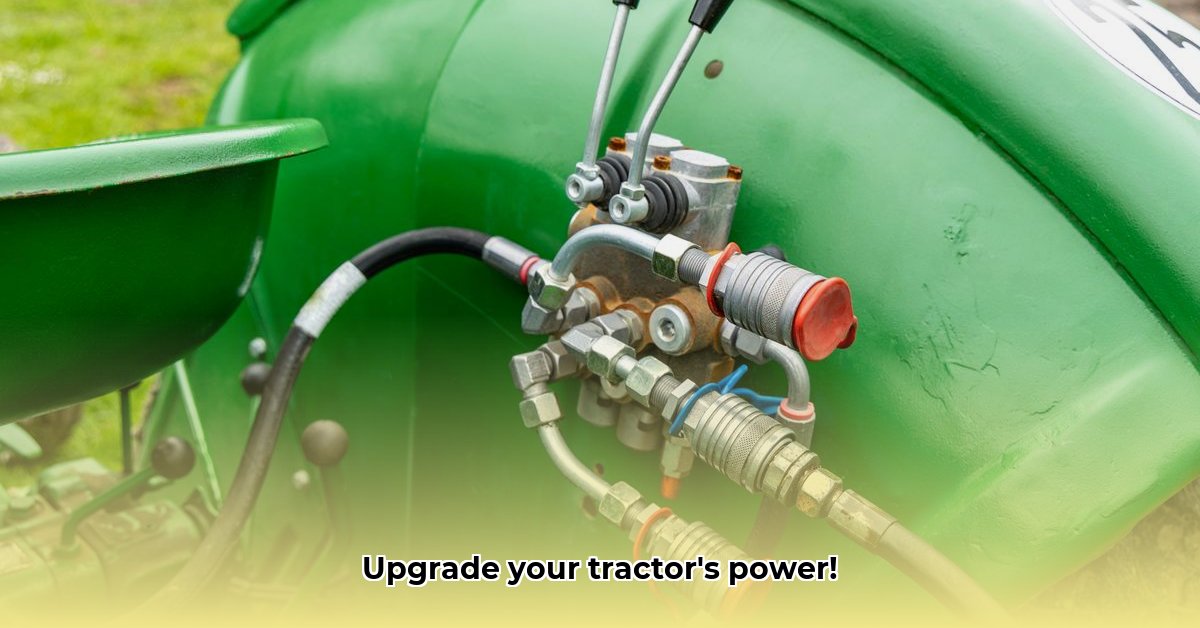
Adding hydraulic remotes significantly enhances your tractor's versatility, allowing you to operate a wider range of implements and complete more tasks efficiently. This comprehensive guide details the process, comparing pre-assembled kits with custom-built systems. For additional tractor attachment options, check out this helpful resource: tractor attachments. Whether you're a seasoned mechanic or a DIY enthusiast, this guide will empower you to make the right decision and safely upgrade your tractor's capabilities.
Planning Your Hydraulic Upgrade: Assessing Your Needs
Before beginning, carefully assess your specific requirements. This planning phase is crucial for avoiding costly mistakes and ensuring a seamless integration. Key factors to consider include:
- Number of Remotes: How many additional hydraulic outputs do you require? (e.g., one, two, or more).
- Flow Rate (gallons per minute - GPM): This determines the power of your hydraulic system. Check your implements' specifications for their required flow rates. Higher flow rates mean more powerful operation.
- Pressure Requirements (PSI): The pressure rating of your implements dictates the necessary pressure capacity of your hydraulic system. Insufficient pressure will result in poor performance.
- Existing Hydraulic System: Understanding your tractor's current hydraulic system's capacity (pump output) and pressure is essential. Adding substantial extra demands may necessitate upgrading your tractor's pump or other components. Consult your tractor's manual.
Option 1: The Convenience of Pre-Assembled Kits
Pre-assembled kits offer a simple, cost-effective solution for adding hydraulic remotes, particularly suitable for those comfortable with basic mechanical tasks. Many are designed for straightforward "plug-and-play" installation.
Pros:
- Simplified Installation: Typically easier to install than custom systems, often with clear, step-by-step instructions.
- Lower Upfront Cost: Generally less expensive than building a custom system.
- Complete Package: Everything you need (valves, hoses, fittings) is included in one package.
Cons:
- Limited Flexibility: Kits usually offer a fixed configuration, limiting customization options. Your needs may not perfectly align with the kit's capabilities.
- Potential Capacity Limitations: Kits may not be robust enough for high-demand applications or larger implements requiring higher flow rates.
- Compatibility Issues: Ensure the kit is compatible with your specific tractor model and existing hydraulic system.
Step-by-Step Installation (Pre-assembled Kit):
- Safety First: Always disconnect the battery's negative terminal. Wear safety glasses and gloves. Consult your tractor's manual and the kit's instructions.
- Valve Block Mounting: Choose an accessible, secure mounting location for the valve block (avoid moving parts).
- Hydraulic Connections: Connect hydraulic lines firmly to the valve block and your tractor's hydraulic system. Double-check for leaks; even minor leaks can cause significant problems.
- Electrical Connections (If Applicable): Some kits include electrical components. Connect these carefully, paying close attention to polarity.
- Testing and Leak Checking: Before use, thoroughly test the system for leaks and responsiveness. Operate the remotes through their full range, checking for smooth operation and the absence of any leaks.
Option 2: The Precision of Custom Systems
A custom-built system offers superior flexibility and control, particularly valuable for complex hydraulic applications or high-demand situations. This requires more mechanical expertise and time investment.
Pros:
- Complete Customization: Allows you to precisely tailor the system to your unique requirements, optimizing flow rates, pressures, and number of remotes.
- Enhanced Robustness: You choose individual, high-quality components designed for long-term durability and demanding workloads.
- Optimized Performance: Fine-tune the flow rates and pressures to perfectly match your implements.
Cons:
- Increased Complexity: Requires significant mechanical knowledge and experience.
- Higher Initial Cost: Individual components can be more expensive than a pre-assembled kit.
- Greater Time Commitment: Design, sourcing, assembly, and testing demand a considerable time investment.
Building a Custom System:
- Detailed Design: Carefully plan the system's layout, including valve placement, hydraulic line routing, and accessibility.
- Component Selection: Choose high-quality components from reputable suppliers, considering flow rates, pressure ratings, and material compatibility.
- Careful Assembly: Securely mount valves and ensure adequate clearance. Precise assembly prevents leaks and failures.
- Meticulous Line Installation: Use appropriate fittings and carefully install hydraulic lines, double-checking all connections for leaks.
- Rigorous Testing: Thoroughly test the entire system to identify and correct any issues before operation.
Safety Precautions: Prioritizing Safety
Working with hydraulic systems involves high-pressure fluids and potential hazards. Always:
- Wear Protective Gear: Safety glasses, heavy-duty gloves, and appropriate clothing are essential.
- Consult Manuals: Review your tractor's manual and all component instructions carefully.
- Use Proper Tools: Employ the correct tools for each task; improper tools can lead to damage or injury.
- Never Work on a Running System: Always disconnect the power and hydraulic system before working on it.
- Regular Inspection: Regularly check hoses, fittings, and connections for damage or leaks.
Troubleshooting Common Issues
- Leaks: Check all connections, fittings, and hoses. Tighten fittings or replace damaged hoses or seals.
- Slow Response: Air in the system may be the cause. Bleed the lines according to your component manufacturer’s instructions. Check for clogged filters.
- No Function: Inspect electrical connections (if applicable) and verify the hydraulic valve is correctly configured.
Adding hydraulic remotes significantly enhances your tractor's capabilities. Choose the approach that aligns with your skills and resources, always prioritizing safety. If you're uncertain about any aspect of this process, consult a qualified mechanic.